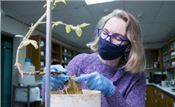|
Researchers Receive $499,936 Grant To Investigate Molecular Signals That Initiate Plant Defenses Against Nematodes, Soilborne Diseases

Fiona Goggin, professor of entomology, extracts root-knot nematodes from a hydroponic nursery. The soilborne pests are
uses in Division of Agriculture research to improve the plant defense response in soybeans
to infection from nematodes and other soilborne diseases.
UA System Division of Agriculture photo by Fred Miller
FAYETTEVILLE, ARK.
Plants come with pretty good security alert systems against pests and maladies. But entomologist Fiona Goggin wants to give them an upgrade to mount faster, more robust defenses against diseases and nematodes that attack them through the soil.
Goggin is a professor of entomology in the Arkansas Agricultural Experiment Station, the University of Arkansas System Division of Agriculture’s research arm. She has spent years studying the interactions of plants and insects with an eye toward developing safe biological pest control.
The U.S. Department of Agriculture’s National Institute of Food and Agriculture awarded a $499,936 grant to Goggin and co-investigators John Rupe and Alejandro Rojas to investigate methods of boosting the defense response of soybeans against nematodes and soilborne pathogens.
Goggin said that even though plant-parasitic nematodes are tiny, often microscopic, roundworms, they are typically regarded as pathogens by plant pathologists.
Rupe and Rojas, both plant pathologists, and Goggin are colleagues in the Agricultural Experiment Station’s department of entomology and plant pathology. Once separate departments, the two were combined in 2019, in part because insects are frequently transmitters of plant diseases.
“This project is a nice partnership between entomology and plant pathology,” Goggin said. “It’s a good department-building collaboration since our two departments have combined into one.”
Research purpose
Goggin said soybeans are the second-largest crop in the U.S. According to the 2020 Arkansas Agricultural Profile, Arkansas is 11th in the country in soybean production, and it is the leading row crop in the state. In 2018, soybeans contributed $1.36 billion to Arkansas’ agricultural economy.
Download the Pocket Facts version of the 2020 Arkansas Agricultural Profile in PDF format here: https://bit.ly/AAES-AgProfile2020
Goggin said that every year, American soybean growers suffer billions of dollars in yield losses to nematodes and other soilborne pathogens. Many of these soilborne pathogens, including root-knot nematodes, attack a wide variety of other crops.
“Chemical controls for soilborne pathogens are becoming increasingly limited due to concerns about their environmental impacts and worker safety,” Goggin said. “Therefore, there is a pressing need to develop alternative techniques for the management of nematodes and other root diseases.”
Research focus
In her research on the defense response of soybean plants to root-knot nematodes, Goggin is focusing on plant elicitor peptides (PEPs). These are native signaling molecules that initiate a defense response in plants damaged by nematodes or disease.
Peptides are amino acid chains that are shorter than proteins, Goggin said. She works with PEPs that respond to nematodes or other soilborne root diseases.
Goggin said the signaling process begins with propeptides – amino acid chains that are larger than peptides but are not biologically active. “They serve as disease or pest alarms – much like burglar alarms installed in windows or doors,” she said. “When a disease damages the plant, they are broken. Part of the broken propeptide is a PEP that then becomes biologically active and elicits a defense response in the plant.”
Goggin said biologists refer to this as a damage-associated molecular pattern. Her goal is to increase the level of propeptides in the plants to boost the defense response.
“Research has shown that when the levels of propeptides increase, plants become more resistant to diseases,” she said.
Making it work
Goggin, Rupe and Rojas are looking at potential methods to achieve higher levels of peptides.
“We could use genetic engineering to increase the levels of propeptides in soybeans and potentially other crop plants,” Goggin said.
Genetically modified organisms are controversial and greatly restricted in many countries. As an alternative, Goggin is looking at two potential methods of coating the seeds with a peptide layer. Seed coating may offer improved nematode and disease resistance during the critical early stages of plant growth, she said.
One method under investigation is to artificially synthesize peptides for seed coatings. “This offers a non-GMO alternative that can be used with any crop variety a grower prefers,” Goggin said. She is looking at multiple ways to reduce the relatively high cost of synthesizing propeptides.
Another method under investigation is to engineer beneficial rhizobacteria to synthesize the peptides and to apply the bacteria as a biocontrol seed. These root-associated bacteria form symbiotic relationships with many plants, including soybeans.
“The rhizobacteria offer a less costly way to produce than synthetic propeptides,” Goggin said. “They also can offer resistance to other soilborne diseases that affect crop seeds and seedlings.”
Two of Goggin’s out-of-state co-investigators – Cynthia Gleason at Washington State University and Lei Zhang at Perdue University – are working out a bacterial delivery system to use the rhizobacteria as a biological control agent.
Goggin said her research team would test each approach’s effects on infection by nematodes and economically harmful pathogens. “We will also more broadly assess the effects of these treatments on soil health, or the balance between pathogenic and beneficial microbes in the soil,” she said.
They also will test the effects of each approach on plant growth, health, and yields, Goggin said.
Going forward
“If PEPs prove useful for crop protection in soybean, our results could, in the future, be extended to many other crops because these signaling compounds are found in a wide range of plant species,” Goggin said. “This research seeks to enable biologically based pest management, which enhances our agricultural economy while also contributing to food safety and environmental protection.” ∆
|
|